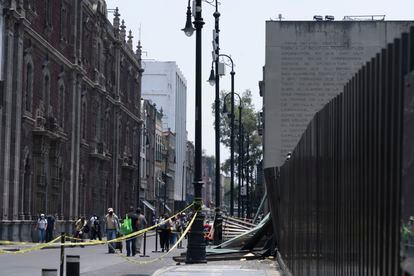The collapsed roof of the Casa de las Águilas, in the Templo Mayor.Monica Gonzalez / El País
From a bird's eye view, the roof of the House of the Eagles looks like a huge unmade bed, all wrinkled, barely supported by the walls of the old ritual building. From the terrace of the Porrúa bookstore, in the center of Mexico City, right in front of the archaeological complex, the image is horrifying: dozens of twisted iron, the fence spoiled and especially the uncertainty that the future holds. With the rainy season just around the corner, archaeologists suffer for the health of the building's invaluable wall paintings, until yesterday protected by the ancient ceiling.
The collapse of the roof highlights its obsolescence.
Rediscovered in 1980, the House of the Eagles had a new roof in 1982. The institute also commissioned three other roofs, one for the ruins of the Templo Mayor pyramid and another two for the so-called red temples, all with the intention of protecting wall paintings.
Designed by Pedro Ramírez, the great architect of the PRI, architect of the Azteca Stadium or the Basilica of Guadalupe, the roofs have withstood the earthquakes of 1985 and 2017, in addition to the torrential rains of each season.
Now they seem to have reached their limit.
More information
"I would like to excavate the Moctezuma zoo"
This Thursday, the director of the Templo Mayor project, Leonardo López Luján, and Michelle De Anda, architect and restorer of the complex, have analyzed the consequences of the collapse and the state of the other three roofs. The one that worries them the most is the one that covers the second construction stage of the old pyramid of the Templo Mayor, the Huey Teocalli, the largest after the one that covered the Casa de las Águilas. "It is about to collapse," López Luján said in an interview with EL PAÍS. “You have to change it because an earthquake or hailstorm can throw it away: the tubes that hold them are angled. They are obsolete ”, he assured.
Since Wednesday, heavyweights of the national archeology have been in talks with the Ministry of Culture to ensure the replacement.
Not only from the Casa de las Águilas, but also from others.
Sources consulted by EL PAÍS indicate that Culture has committed to the replacement, although delivery dates have not yet been handled.
The Templo Mayor is one of the most important archaeological sites in Mexico.
Visited by thousands of people every year, its relevance transcends the tourist and points to the political, especially now, when the federal government and that of the capital have made the pre-Hispanic past one of their discursive signs.
View from the street of the collapse of the roof.Monica Gonzalez / El País
"It is incredible that there are no serious effects," explained López Luján this Thursday, referring to the Casa de las Águilas.
“After the roof collapsed, Civil Protection allowed us to approach the house from all sides.
And so with flashlights and CCTV images we could see that the sidewalks and wall paintings were fine, "he added.
The problem now points to the care of the building's heritage.
The National Institute of Anthropology and History (INAH) plans to remove the damaged cover.
Archaeologists and restorers from the project will cover the paintings and sidewalks to protect it from the elements.
"Disassembling the cover does not have too much complication, the problem is that until the new one arrives the place will be uncovered", said López Luján.
image of the roof after the storm.Monica Gonzalez / El País
The fragility of the Casa de las Aguilas wall paintings has archaeologists concerned. The composition of the walls make conservation a challenge, more without a roof. Adriana Sanromán, restorer of the project, explains that "the paintings on the walls have an atypical substrate, made with flattened earth, like a coating of layers of clay". The expert adds that “in other buildings of the Templo Mayor, the wall paintings were placed on substrates of lime and sand. And the lime at the end has the setting process. When it dries, calcium carbonate forms, which is stable and hard. It can dissolve, but the protection is much greater ”.
Sanromán draws a complicated panorama, more with the rains at the door.
“Sure, what happens when water falls on the ground?
These soils have clay and can be very swollen.
And since they do not have a setting, they are very delicate ”, he argues.
"Although the paintings have had conservation processes, having them outdoors is not the best thing to do, not even for a short time," he says.
Subscribe here
to the
newsletter
of EL PAÍS México and receive all the informative keys of the current situation of this country

